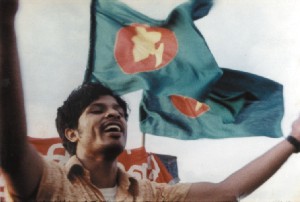The stellar role of cultural activists in our Liberation War
Swapan Chowdhury's vision of the warfront
Fayza Haq
'When the War of Liberation began there were many artists working in Calcutta, Delhi and Patna in 1971,' reminisces Swapan Chowdhury, sitting at his Parjatan office. 'With me were Devdas Chokroborty, Nitun Kundu, Nasser, Kaji Ghias, Hashi Chorkoborty and Biren Shome. I had graduated from the Dhaka Art College and sang on trucks and painted pictures. Most of the artists left their paintings behind but I brought all my paintings to Dhaka,' he said.Swapan Chowdhury said that he was a firm believer in art for art's sake. He doesn't believe that there has to be social or political drive behind a painting. In his view, the quality of good paintings have been maintained since the ancient times as seen in Ellora, Ajanta (both in India) and Altimira (Spain). 'I did not want to take my paintings to the battlefield but to bring the war to my canvases. There is love and romanticism even in the war scenes. I have also expressed my hate for my enemy. I have depicted this through lines, colours, symbols and posed figures. There is not a single delineation of a gun in all my 200 paintings. I haven't brought in tanks or planes. I have shown woman's figures, eagles, vultures all fighting against the common enemy. I show everyone fighting against a monstrous animal, the enemy.' Swapan Chowdhury hasn't shown just the rape of a woman but her torment and screams. After the war, when he went to paint, he found that the people who were fighting against terror and injustice were themselves involved in wrongdoing. He found that the freedom fighters had joined hands with the Razakars and so he had no desire to paint anymore on the theme of the Liberation War. Swapan Chowdhury hopes to give his paintings on the War to a new Liberation War Museum. The only understanding would be that the pictures be preserved properly. Asked why he had not given his paintings to the existing Liberation War museum, he said that the authorities did not want them, perhaps due to lack of room to preserve the paintings. On the occasion of the 25th year of Bangladesh's existence the paintings had been exhibited at the Shilpakala Academy. In Swapan Chowdhury's works, a good number of drawings have topsy-turvied forms in tempera and pastel as well as abstractions. In them we feel that the artist has metaphorically walked through the roads of Calcutta with the bleeding map of Bangladesh labelled on his chest. Forms of suffering human beings have been transformed to have new meanings on his canvas. Deformation of shapes brings new meanings to ordinary figures and shapes. The fineness of his lines together with the many dimensional shapes gives new meanings to his subjects. As he breaks his figures he gets stylised forms. In War in Bengal we find human forms, birds and animals fighting against a common enemy, a giant black horse. In Mother we see a woman fighting with her child against a demon serpent. Horrible city presents nude women swimming through a blood drenched city. Love and war is an amalgamation of forms in the shape of horses, serpents and humans to show the struggle of the war. Joy of victory has simple human forms, spears in hands, leaping and floating to victory. He had painted a 27-feet painting and this work, inaugurated by Sufia Kamal, was signed by 5,000 viewers including six sector commanders. He has done such paintings for Chittagong and Faridpur exhibitions also. Swapan Chowdhury says that the greatest pride in his life is his role in the Liberation War Movement.
|

Swapan Chowdhury in a still from Muktir Gaan |